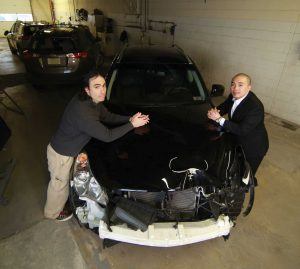During his daily commute from South Jersey to Willow Grove, Pa., in the 1990s, Mike Kahn had lots of drive time to ponder the large number of accidents he regularly witnessed.
“It was a long ride on a basically straight portion of highway with no turns and no real hills, and weather wasn’t usually a factor,” recalls the Cherry Hill father of three. “Yet there seemed to be two or three accidents per week.”
 These observations – from a time before cell phones became a driving distraction – were the seeds of the recently published “Don’t Die In A Car,” a drivers’ manual he wrote with his brother-in-law, Robert Lacorte, who happens to be a driving instructor. The book specifically targets teens and other new drivers.
These observations – from a time before cell phones became a driving distraction – were the seeds of the recently published “Don’t Die In A Car,” a drivers’ manual he wrote with his brother-in-law, Robert Lacorte, who happens to be a driving instructor. The book specifically targets teens and other new drivers.
An engineer, Kahn sought to understand the patterns and root causes for these car crashes, which often seemed preventable. He started keeping a journal of his findings, jotting down observations of bad driving habits, like tailgaters and lane shifters. There were those who downed their meals with one hand on the wheel, antsy children jumping out of their seats and the harried nine-to-fivers, using their rearview mirror to apply makeup.
The detailed notebook gathered dust for nearly 20 years as life went on. Meanwhile, high-tech distractions introduced new dangers to SJ’s congested roads, including text messaging and Internet browsing. About two years ago, when Lacorte became a part-time driving instructor, the notebook gained new relevance. Equally dismayed by preventable road accidents, Lacorte, a 29-year-old Deptford resident, was intrigued by Kahn’s observations.
“We realized that if we shared information about what I’ve seen on the road and what he’s seen on the road, we may be able to save lives and make a difference,” says Lacorte, who is also a financial analyst. “I’ve also seen a lot of things people are doing wrong behind the wheel that can be improved. I’ve been driving with a student, stopped at a light and seen one or two fender benders I could have called five or 10 seconds before they even happened.”
The collaboration, which produced “Don’t Die In A Car,” was a self-financed project that clearly falls into the labor-of-love category. With a dramatic cover picture of a smashed-beyond-repair automobile, the thin survival guide avoids specific rules of the road covered in most DMV manuals. It instead covers practical scenarios, such as how to avoid being boxed in on highways, how to pass a truck and how to navigate an intersection.
To get through to the audience that would benefit the most, the book is purposely short and includes lots of graphics.
“It’s heavy on visuals with blurbs of text explanations,” says Kahn. “We tried to capture what we believed was the attention span of teenagers, or at least the way they absorb information.”
The book, available on Amazon.com as both a traditional manual and Kindle eBook, debuted late last year, coincidentally just days after actor Paul Walker died when a red Porsche he was riding in crashed and exploded in California.
“Not that we would have wanted to see it that way, but we did see a bump in sales after he died,” says Kahn.
In the months since it was published, the book has reached number 12 in Kindle’s Driving Safety Education category.
With the frequency that people text and talk on phones while driving and speed through changing lights and tailgate, it may be surprising to learn that automobile fatalities have actually declined in recent years.
Some 15,470 people died in all forms of motor vehicle crashes between January 1 and June 30, 2013 – down from the 16,150 fatalities reported during the first half of 2012, according to the National Highway Traffic Safety Administration.
Overall, road deaths have fallen 26 percent since 2005 and have dropped by more than 40 percent since hitting a peak of 54,589 in 1972, back in the dark days before seat belts were required.
Experts attribute the decline in fatalities to a number of factors, including advances in car-safety technologies, like air bags and advanced-collision avoidance systems. Public safety crackdowns of drunk and distracted drivers have also helped.
While the trend is promising, distracted driving – defined as operating a motor vehicle while doing another activity that takes attention away from the road – is still a major public safety issue, particularly for young drivers. Each day in the United States, more than nine people are killed and more than 1,060 people are injured in crashes linked to distracted driving, according to the Centers for Disease Control and Prevention (CDC).
Thirty-one percent of U.S. drivers ages 18-64 reported that they had read or sent text messages or email messages while driving at least once within the 30 days before they were surveyed, according to the CDC. However, younger, inexperienced drivers may be at an increased risk. They have the highest proportion of distraction-related fatal crashes.
Motor vehicle crashes are the leading cause of death for U.S. teens, reports the CDC. In 2010, for example, an average of seven teens – ages 16 to 19 – died every day from motor vehicle injuries. Per miledriven, teen drivers are three times more likely than drivers over 20 to be involved in a fatal crash.
Since 2000, New Jersey’s youngest drivers – 16-year-olds – have been required to take six hours of lessons with a state licensed driving instructor to obtain their learner’s permit.
Rosie Bellace, former owner of S&L Driving School in Swedesboro, says these lessons offer a golden opportunity to drive home all the vital points about safety. Among the most essential: she always required her students to turn off their phones before taking the keys.
“If they put the phone on vibrate, they will check it,” says Bellace.
Another danger facing all drivers, but particularly teens, she says, is drowsy driving.
In a recent study, drivers ages 17 to 24 who reported sleeping six or fewer hours per night were about 20 percent more likely to be involved in a car crash over a two-year period, compared with those who slept more than six hours a night, according to the medical journal JAMA Pediatrics. A study published in the Journal of Adolescent Health found that as many as two-thirds of high school students get less than seven hours of sleep nightly.
“A lot of kids have too much on their plate,” she says. “They’re just tired all the time. It’s a problem up there with texting.”
While students are always eager to learn to drive and earnest about staying safe, Bellace says parents can only hope they take all the lessons to heart. She believes “Don’t Die In A Car” can prompt conversations leading to greater road awareness.
“It’s certainly not comprehensive, but it’s a wonderful starting place to initiate a conversation with your first-time driver,” she says. “These topics are hot topics, and they need to be talked about.”
For Justin Hastings, a junior at West Deptford High School who has looked forward to driving since he was 12, the experience of actually being behind the wheel has helped him realize the serious responsibility that comes with the privilege. Beyond his driver’s education course, studying the manual and actual driving, “Don’t Die In A Car” has rounded out his preparations.
“The book includes all these rules that no one kind of knows about because you don’t get tested on it or in trouble for it,” says Hastings. “But in the long run it will keep you safer.”












